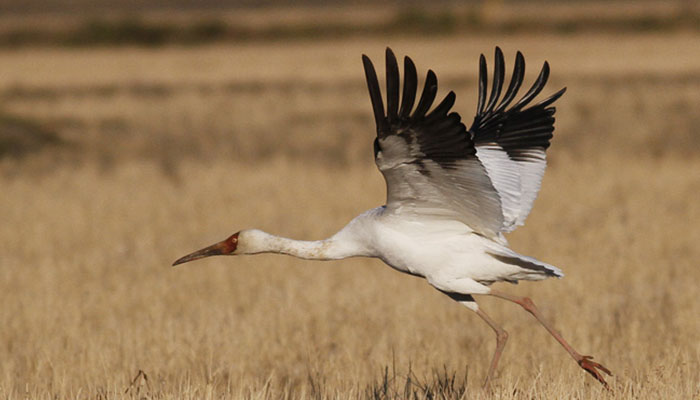
English: Siberian
Crane, Siberian White Crane, Great White Crane
Russian: Стерх
German: Schneekranich
French: Grue
de Siberie
Mongolian: Цагаан тогоруу
Japanese: ソデグロヅル (Sodeguro-zuru)
Status: Very rare species. According to the
IUCN Red List categories and criteria, the species evaluated as-Critically
Endangered.
Distribution and Range: The Siberian White Crane breeds along the middle of the Obi
River and the north-eastern part of Yakutia, Russia. In Yakutia its
distribution area spans over large territory between Yanoi River and Alaze
River to the east. The species winter at the estuary of the Khokh River in
China. In Mongolia: A rare summer resident, passage migrant. It was recorded
along the Buur and Tari Lakes, and Bukheg River basin. Summer resident along
the Ulz River in 1981 and 1988, and Ogii Lake in 1994. In summers of the last 5
years 8-10 individuals have been sighted several times at the Binder Lake and
its surrounding areas.
Habitat: The preferred nesting habitat Yakutian tundra was found to
consist of biotope of several small and big lakes with damp polygonal tundra
and is surrounded with coniferous forests. In Mongolia, arrives end of April,
beginning of May, the non-breeding resting areas and stopovers on migration
tend to consist of large, isolated wetlands.
Population and Threats: It is estimated that there are 840 birds in Yakutia and 50 along
the Obi River. Very rarely seen in Mongolia. In 1994, only 5 were recorded near
Ogii Lake, one of which was a juvenile Spends summer in Mongolia, therefore
disturbances from livestock and humans in the distribution area.
Conservation Measures: Hunting prohibited since
1995. Included as very rare animal in the Mongolian Law on Fauna, CITES Annex
I, CMS Annex I and II, the Mongolian Red Book (1987, 1997), and the Asia Red
Data Book for Birds(2001). The habitat is partially included within the
National Specially Protected Area Network (NSPAN).
Further Actions: Improve distribution area according the requirements of the
appropriate laws and conventions; implement public awareness programmes.